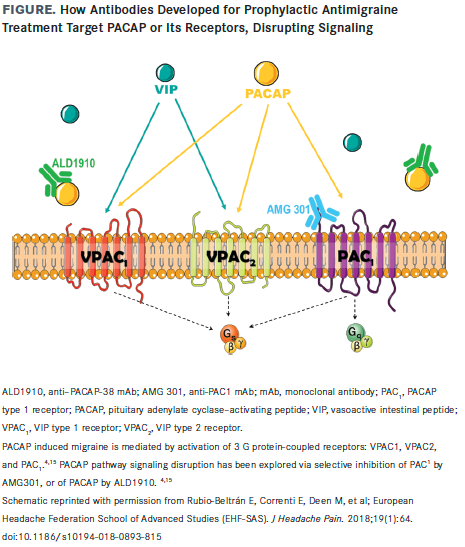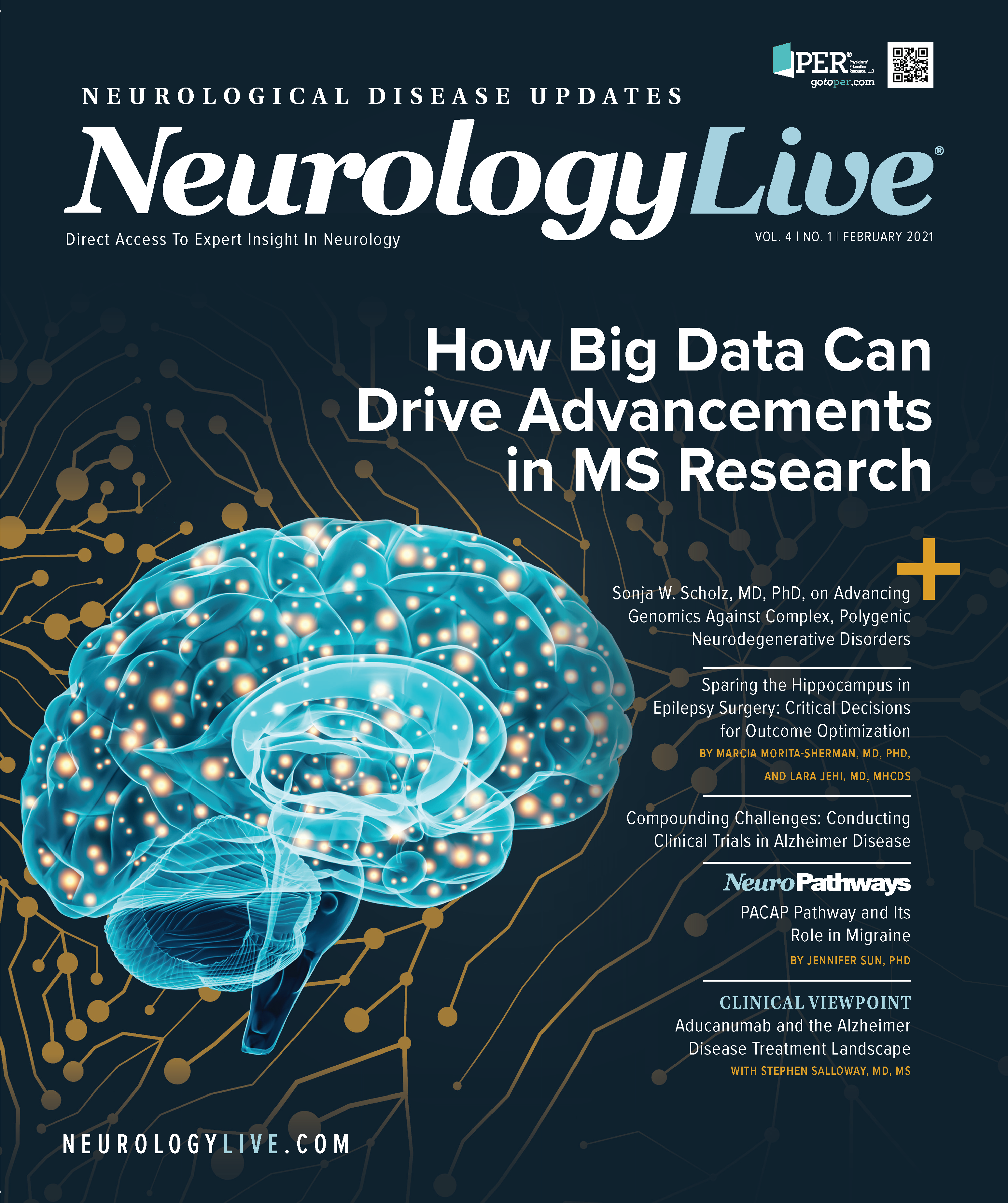Publication
Article
NeurologyLive
PACAP Pathway and Its Role in Migraine
Author(s):
The PACAP pathway has shown promise as a potential novel therapeutic target in the treatment of migraine.

Migraine is a heritable,1-3 complex brain disorder that produces an assortment of neurological and systemic effects.4 Diagnosis is based on criteria related to the number and duration of attacks, as well as headache characteristics and the presence of accompanying symptoms.5,6 These symptoms are often debilitating and can be triggered by hormonal fluctuations or stress.3,6 Further, patients with migraine are more likely to experience medication overuse headache and comorbidities such as insomnia, depression, anxiety, gastric ulcers, and gastrointestinal bleeding.1,6
Jennifer S. Sun, PhD

Despite the prevalence and significant burden of migraine,6,7 the majority of patients living with the disorder are overlooked6 or treated unsatisfactorily.5 This is due in part to the challenge of identifying effective treatment to address the complex pathophysiology of migraine.4,5 Lack of efficacy and the development of adverse effects (AEs) often result consequently in patients’ dissatisfication with medications, particularly before the recent advent of more targeted preventive migraine treatments.5 The continued development of such agents promises to change this landscape.
Investigational migraine therapeutics focus on receptors of the trigeminovascular system, the activation and sensitization of which yields migraine headaches.2,3 Eptinezumab (Vyepti, Lundbeck Seattle BioPharmaceuticals), a humanized monoclonal antibody (mAb) inhibitor of the calcitonin gene-related peptide (CGRP), received FDA approval in February 2020 as the first intravenous migraine prophylactic in adults.6 Clinical trials,8-11 along with an open-label safety study12 and pharmacokinetic data,13 show that quarterly infusions of eptinezumab achieve 100% bioavailability13 after administration and significantly decrease the number of migraines experienced per month. Modulation of other signaling systems and factors which are involved upstream or alongside the trigeminovascular system (the endocannabinoid system6) are also being considered for therapy development. These factors can potentially be used in combination therapy with CGRP active agents.6 Of particular recent interest is the pituitary adenylate cyclase–activating peptide (PACAP) signaling pathway.
PACAP is a pleiotropic signaling neuropeptide4 belonging to the glucagon-growth hormone–releasing factor-secretin superfamily.5 It exists in 2 biologically active forms, PACAP-27 and PACAP-38.7,14 PACAP-38, the predominant form, shows a remarkable degree of evolutionary conservation.15 PACAP is known to regulate learning, memory, and behavior7,16 through its modulation of neuronal growth, development, and repair.4,16 It shares important close anatomical similarities with CGRP in central nervous system regions associated with migraine pathophysiology,17 suggesting that PACAP may play a role similar to that of CGRP in its contribution to migraine.1 Preclinical data, however, indicate that PACAP and CGRP have differentiated pharmacology with respect to migraine-associated symptoms.1
Human studies confirm PACAP as a key player in migraine pathophysiology. Intravenous administration of PACAP-38 caused headache in all healthy subjects and migraine-like attacks in 58% of patients with a history of migraine without aura (NCT00380263).18,19 However, administration of a functionally related neuropeptide, vasoactive intestinal peptide (VIP), did not induce migraine-like attacks in patients with migraine.15 PACAP-38 is released from both the parasympathetic and sensory system.20 Consequent PACAP-38-induced migraine in the sensory system is attributed to modulation of nociceptors outside the blood-brain barrier.7 PACAP-38-mediated vasodilation through the sensory nerves that innervate the cranial vasculature may contribute to pain during migraine attacks.6,7 Moreover, a clinical trial demonstrated that plasma PACAP-38 levels were increased after PACAP-38 infusion in patients who subsequently experienced migraine attacks (NCT01471990),2,21,22 suggesting de novo synthesis or release of PACAP-38 during migraine.21 PACAP may therefore be useful as a biomarker of primary headaches.17,20
PACAP’s actions are mediated through 3 G protein-coupled receptors: VIP type 1 receptor, VIP type 2 receptor, and PACAP type 1 (PAC1) receptor.15 Studies indicate that the PAC1 receptor is the most important mediator of PACAP signaling, perhaps due to its 1000-fold higher affinity for PACAP than for VIP.7,15 Both PACAP and the PAC1 receptor have thus been suggested as novel targets for migraine treatment, which might provide new therapeutic options for patients who do not respond to CGRP-blocking drugs (FIGURE).15 Unfortunately, no statistically significant differences in mean monthly migraine days were found in a phase 2a, randomized, double-blind, placebo-controlled study of the safety and efficacy of 12 weeks of treatment with AMG 301 (Amgen; NCT03238781),23 a PAC1 receptor–targeting mAb. However, anti- PACAP antibodies still have the potential to be effective in the treatment of migraine.4
FIGURE. How Antibodies Developed for Prophylactic Antimigraine Treatment Target PACAP or Its Receptors, Disrupting Signaling

ALD1910 (Alder BioPharmaceuticals)24 is a potent, selective, high-affinity, neutralizing mAb that targets both PACAP-271 and PACAP-381,5 to block PACAP signaling, offering a new mechanism-specific approach for migraine therapy. ALD1910 recognizes a nonlinear epitope within PACAP-38 and effectively blocks its binding to its cell-surface receptors in a dose-dependent manner.1 A first-in-human, randomized, double-blind, placebo-controlled study (NCT04197349)24 in a healthy population began in September 2019 to assess the safety, tolerability, and pharmacokinetic profile of ALD1910 at 7 ascending doses. This study was completed in August 2020, with results forthcoming.
Considering the prevalence and heterogeneity of migraine,1,5,6 the development of therapeutic agents with mechanistically diverse targets will lead to more treatment options. A number of migraine regulators have been identified as promising targets. Targeting multiple levels in the same pathway might lead to more effective prevention of migraine.6 However, selective antibodies have the greatest therapeutic potential; such agents should reduce potential AEs while maintaining efficacy for most patients with migraine.15 mAbs that block activation of the trigeminovascular system should potently prevent the onset of migraine attacks.2,3,6 The ideal agent would exhibit limited drug-drug interactions, an important consideration in a patient population susceptible to polypharmacy.4
REFERENCES
1. Moldovan Loomis C, Dutzar B, Ojala EW, et al. Pharmacologic Characterization of ALD1910, a Potent Humanized Monoclonal Antibody against the Pituitary Adenylate Cyclase-Activating Peptide. J Pharmacol Exp Ther. 2019;369(1):26-36. doi:10.1124/jpet.118.253443
2. Vécsei L, Tuka B, Tajti J. Role of PACAP in migraine headaches. Brain. 2014;137(3):650-651. doi:10.1093/brain/awu014
3. Noseda R, Burstein R. Migraine pathophysiology: anatomy of the trigeminovascular pathway and associated neurological symptoms, CSD, sensitization and modulation of pain. Pain. 2013;154 Suppl 1. doi:10.1016/j.pain.2013.07.021
4. Rustichelli C, Castro FL, Baraldi C, Ferrari A. Targeting pituitary adenylate cyclase-activating polypeptide (PACAP) with monoclonal antibodies in migraine prevention: a brief review. Expert Opin Investig Drugs. 2020;29(11):1269-1275. doi:10.1080/13543784.2020.1811966
5. Bertels Z, Pradhan AAA. Emerging Treatment Targets for Migraine and Other Headaches. Headache J Head Face Pain. 2019;59(S2):50-65. doi:https://doi.org/10.1111/head.13585
6. Brevig T, Cady R, Hellsten J, et al. Preventing migraine from taking over people’s lives: Lundbeck’s perspective and current research. :4.
7. Schytz HW, Olesen J, Ashina M. The PACAP receptor: A novel target for migraine treatment. Neurotherapeutics. 2010;7(2):191-196. doi:10.1016/j.nurt.2010.02.003
8. Ashina M, Saper J, Cady R, et al. Eptinezumab in episodic migraine: A randomized, double-blind, placebo-controlled study (PROMISE-1). Cephalalgia. 2020;40(3):241-254. doi:10.1177/0333102420905132
9. Dodick DW, Lipton RB, Silberstein S, et al. Eptinezumab for prevention of chronic migraine: A randomized phase 2b clinical trial. Cephalalgia. 2019;39(9):1075-1085. doi:10.1177/0333102419858355
10. Lipton RB, Goadsby PJ, Smith J, et al. Efficacy and safety of eptinezumab in patients with chronic migraine: PROMISE-2. Neurology. 2020;94(13):e1365-e1377. doi:10.1212/WNL.0000000000009169
11. Silberstein S, Diamond M, Hindiyeh NA, et al. Eptinezumab for the prevention of chronic migraine: efficacy and safety through 24 weeks of treatment in the phase 3 PROMISE-2 (Prevention of migraine via intravenous ALD403 safety and efficacy–2) study. J Headache Pain. 2020;21(1):120. doi:10.1186/ s10194-020-01186-3
12. Alder Biopharmaceuticals, Inc. An Open Label Phase 3 Trial to Evaluate the Safety of ALD403 Administered Intravenously in Patients With Chronic Migraines (PREVAIL). clinicaltrials.gov; 2020. Accessed January 14, 2021. https://clinicaltrials.gov/ct2/show/NCT02985398
13. Baker B, Schaeffler B, Beliveau M, et al. Population pharmacokinetic and exposure‐response analysis of eptinezumab in the treatment of episodic and chronic migraine. Pharmacol Res Perspect. 2020;8(2). doi:10.1002/prp2.567
14. Juhász T, Szentléleky E, Szűcs Somogyi C, et al. Pituitary Adenylate Cyclase Activating Polypeptide (PACAP) Pathway Is Induced by Mechanical Load and Reduces the Activity of Hedgehog Signaling in Chondrogenic Micromass Cell Cultures. Int J Mol Sci. 2015;16(8):17344-17367. doi:10.3390/ijms160817344
15. Rubio-Beltrán E, Correnti E, Deen M, et al. PACAP38 and PAC1 receptor blockade: a new target for headache? J Headache Pain. 2018;19(1):64. doi:10.1186/s10194-018-0893-8
16. Johnson GC, May V, Parsons RL, Hammack SE. Parallel signaling pathways of pituitary adenylate cyclase activating polypeptide (PACAP) regulate several intrinsic ion channels. Ann N Y Acad Sci. 2019;1455(1):105-112. doi:https://doi.org/10.1111/nyas.14116
17. Edvinsson L, Tajti J, Szalárdy L, Vécsei L. PACAP and its role in primary headaches. J Headache Pain. 2018;19(1). doi:10.1186/s10194-018-0852-4
18. Danish Headache Center. Basic Scientific Research Investigating PACAP38 Headache Inducing Effects in Migraine Patients. clinicaltrials.gov; 2008. Accessed December 27, 2020. https://clinicaltrials.gov/ct2/show/NCT00380263
19. Schytz HW, Birk S, Wienecke T, Kruuse C, Olesen J, Ashina M. PACAP38 induces migraine-like attacks in patients with migraine without aura. Brain. 2009;132(1):16-25. doi:10.1093/brain/awn307
20. Ashina H, Guo S, Vollesen ALH, Ashina M. PACAP38 in human models of primary headaches. J Headache Pain. 2017;18(1):110. doi:10.1186/s10194-017-0821-3
21. Amin FM, Hougaard A, Schytz HW, et al. Investigation of the pathophysiological mechanisms of migraine attacks induced by pituitary adenylate cyclase-activating polypeptide-38. Brain. 2014;137(3):779-794. doi:10.1093/brain/awt369
22. Amin FM. The Effect of PACAP38 and VIP on Migraine Patients Assessed by a 3-Tesla MR Scanner. clinicaltrials.gov; 2012. Accessed January 14, 2021. https://clinicaltrials.gov/ct2/ show/NCT01471990
23. Amgen. A Phase 2a Randomized Double-Blind Placebo Controlled Study to Evaluate the Efficacy and Safety of AMG 301 in Migraine Prevention. clinicaltrials.gov; 2020. Accessed December 27, 2020. https://clinicaltrials.gov/ct2/show/NCT03238781
24. H. Lundbeck A/S. A Randomized, Double-Blind, Placebo-Controlled, Single Ascending Dose Phase 1 Study to Determine the Safety, Tolerability, and Pharmacokinetics of ALD1910, a Humanized Anti- Pituitary Adenylate Cyclase Activating Peptide (PACAP) Monoclonal Antibody. clinicaltrials.gov; 2020. Accessed December 27, 2020. https://clinicaltrials.gov/ct2/show/NCT04197349





